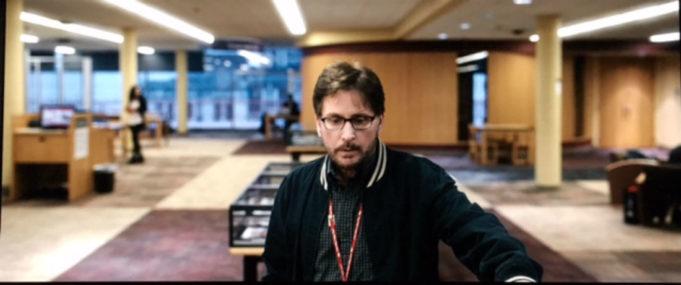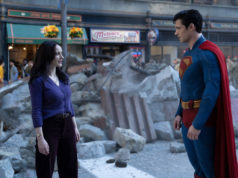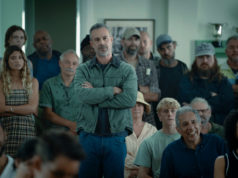What do you say to an actor you’re about to interview that you grew up watching in the movies. Well, if you’re me, you vomit out as many words about how much they impacted your youth as you can.
Multi-hyphenate Emilio Estevez has written and directed seven original films. His latest, The Public, happens to be right in my wheelhouse: the library. (More on that in the interview.)
One month shy of my Master’s in Library Science, I jumped at the opportunity to interview him about the movie. I didn’t get to ask all the burning questions I had written down, but we did have a great conversation. Estevez is a humble filmmaker who clearly cares for subjects he writes about. His film opens at various theaters in Tarrant County on April 5.
CW: I wanted to start out and say when I was a younger and had to missed school, I always watched Young Guns II as well as the first [one], Repo Man, The Breakfast Club, Maximum Overdrive, Loaded Weapon 1, and Men at Work. I wrote about you in my late dad’s tribute because we watched The Mighty Ducks franchise a lot together. I even wrote a paper on Billy the Kid because of how you iconically portrayed him in the Young Guns franchise. It’s pretty safe to say I have a Ph.D. in Emilio Estevez Cinema. Sorry, I had to get that out there.
EE: (laughs) Sorry about that.
CW: Don’t be.
EE: I apologize for the bad ones. There’s been a few of them.
CW: I have to say I couldn’t have seen The Public at a more perfect time. I feel like I’m living [Emilio Estevez’s character] Stuart Goodson’s life. A former drunk turned librarian. But I actually work in archives [versus as a librarian].
EE: You’re working on getting your MLS right now?
CW: Yes. one month away.
EE: So cool.
CW: Yeah, I just hit 90 days sobriety following my dad’s unexpected death. School has helped a lot. You actually came to the library to screen the movie that I interned at in Fort Worth. I wasn’t there, but that was pretty cool.
Let’s talk about your latest film which you wrote, directed, and star in, The Public. First question, what encouraged you to make a film surrounding understanding the library system? While more importantly, covering the homeless and how the library isn’t just a safe haven for them during business hours but they are welcome to come and enjoy everything the library has to offer. Just like a regular patron.
EE: Well I approached writing a script starting the research. Especially if it’s something that is either socially relevant or has some measure of historical relevance to it. So I did the bulk of my research for Bobby, the film that we shot in 2005 at the downtown L.A Public Library, because at the time, most of the information that I needed was not available, had not been transferred to digitally yet. All of that was on microfiche, so I found myself at the library for many months.
The movie was released, it did what it did in terms of box office and award stuff. It ended up being a really interesting experience. I was looking for a follow-up story. This article appeared to me [in the] L.A Times on April 1st, 2007. And it was about it was written by Chip Ward, who is a Salt Lake City librarian. It talked about how he was going to retire, but in leaving the library he felt he had to talk about how libraries have become de facto homeless shelters. And how librarians have become de facto social workers and first responders. It wasn’t just isolated to Salt Lake City, this was in fact an epidemic that was happening across the country.
So I was really moved by the piece and thought “Well, I’m going to go back to my public library downtown and see if this is the case”. I just started hanging out and observing and [decided what] the story would look like if it were a particular cold night, and patrons [who] were essentially using it as a daytime shelter decided to use it as a night time shelter. How law enforcement would react and how the media would spin it. To help local politicians who might change the narrative to suit their own agendas. Again, we think about where we are right now, this is back in 2007 before we have arrived at the place where all the issues and the themes of the movie are now too commonplace. Now, I’m not saying that I’m pressing it in any way I’m just saying that this movie is really relevant now and perhaps more relevant than [if we] had we made it 10 years ago.
CW: Yeah I agree. The story’s underlying theme revolves around the homeless and mental illness. But its not too heavy handed and you give the message that not every homeless person is mentally ill. And how not all who are mentally ill are dangerous. Which I applaud you so much for this grand achievement. Because I’ve had to explain that to a lot of people.
EE: There’s a lot of humor. When you start to talk to individuals, once you get past their distrust, you get past that and you start talking about, how they’ve arrived at this place, the stories are heartbreaking, but some of them are also really funny.
CW: Yeah you did a very great job of dealing with very serious issues well. Peppering humor throughout the film. So I mean there was great work.
EE: Well I feel the humor was important to humanize the characters. Because again, we’re all, nobody wants to live pain-free or trauma-free. We all carry a certain amount of trauma with us. It’s really a matter of degrees and how people deal with it. How they’re coping with it. Each one of these characters, including Stuart and Ramstead the police officer, they’re carrying a certain amount of trauma as well.
CW: Awesome. Love it. I appreciate your time and great work on the film.
EE: Best of luck with you too. On your MLS and blessings on your sobriety and that’s such a giant step. You’re 90 days today?
CW: Uh, 93.
EE: 93, far out man. Keep at it, it works.












